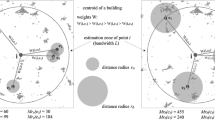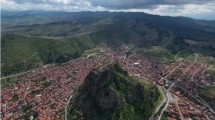Abstract
In this study, some problematic points associated with the application of the box-counting method for the evaluation of the visual complexity of the chosen historic buildings and their surrounding environments are analyzed. The reliability of the results is measured in terms of the variation of the complexity level over different range of scales available in an image. Some rules for the choice of the box sizes used in the box counts are considered and tested in the case of classical fractals with the known theoretical fractal dimension. The proposed algorithm is applied to the evaluations of the fractal dimensions for the historic part of the city of Amasya and its surrounding environment. More accurate computations based on the traditional and new factual material show that there is a strong similarity between the fractal measures of the built and natural landscapes.
Access this chapter
Tax calculation will be finalised at checkout
Purchases are for personal use only
Preview
Unable to display preview. Download preview PDF.
Similar content being viewed by others
References
Batty, M., Longley, P.: Fractal Cities: A Geometry of Form and Function. Academic Press, San Diego (1994)
Batty, M.: Cities and Complexity: Understanding Cities with Cellular Automata, Agent-Based Models, and Fractals. MIT Press, Cambridge (2005)
Bechhoefer, W., Bovill, C.: Fractal analysis of traditional housing in Amasya, Turkey. In: Changing Methodologies in the Field of Traditional Environment Research, pp. 1–21. University of California, Berkeley (1994)
Bisoi, A.K., Mishra, J.: On calculation of fractal dimension of images. Pattern Recognition Letters 2, 631–637 (2001)
Bovill, C.: Fractal Geometry in Architecture and Design. Birkhauser, Boston (1996)
Buczkowski, S., Kyriacos, S., Nekka, F., Cartilier, L.: The modified box-counting method analysis of some characteristic parameters. Pattern Recognition 31, 411–418 (1998)
Burkle-Elizondo, G., Valdez-Cepeda, R.D.: Fractal analysis of Mesoamerican pyramids. Nonlinear Dynamics, Psychology and Life Sciences 10, 105–122 (2006)
Calter, P.A.: Squaring the Circle: Geometry in Art and Architecture. Wiley, Chichester (2008)
Capo, D.: The fractal nature of the architectural orders. Nexus Network Journal 6, 30–40 (2004)
Cardillo, A., Scellato, S., Latora, S., Porta, S.: Structural properties of planar graphs of urban street patterns. Physical Review E 73, 066107-1–066107-8 (2006)
Chen, S.S., Keller, J.M., Crownover, R.M.: On the calculation of fractal features from images. IEEE Transactions on Pattern Analysis and Machine Intelligence 15, 1087–1090 (1993)
Cooper, J., Oskrochi, R.: Fractal analysis of street vistas: a potential tool for assessing levels of visual variety in everyday street scenes. Environment and Planning B: Planning and Design 35, 349–363 (2008)
Cooper, J., Watkinson, D., Oskrochi, R.: Fractal analysis and perception of visual quality in everyday street vistas. Environment and Planning B: Planning and Design 37, 808–822 (2010)
Da Silva, D., Boudon, F., Godin, C., Puech, O., Smith, C., Sinoquet, H.: A critical appraisal of the box counting method to assess the fractal dimension of tree crowns. In: Bebis, G., et al. (eds.) ISVC 2006. LNCS, vol. 4291, pp. 751–760. Springer, Heidelberg (2006)
Falconer, K.J.: Fractal Geometry: Mathematical Foundations and Applications. Wiley, Chichester (2003)
Feng, J., Lin, W.-C., Chen, C.-T.: Fractional box-counting approach to fractal dimension estimation. In: Proceedings of ICPR 1996, pp. 854–858 (1996)
Foroutan-pour, K., Dutilleul, P., Smith, D.L.: Advances in the implementation of the box-counting method of fractal dimension. Applied Mathematics and Computation 105, 195–210 (1999)
Frankhauser, P., Tannier, C.: Fractalyse (2012), http://www.fractalyse.org/en-home.html
Hagerhall, C.M., Purcell, T., Taylor, R.: Fractal dimension of landscape silhouette outlines as a predictor of landscape preference. Journal of Environmental Psychology 24, 247–255 (2004)
Hahn, A.J.: Mathematical Excursions to the World’s Great Buildings. Princeton University Press, Princeton (2012)
Heath, T., Smith, S.G., Lim, B.: Tall buildings and the urban skyline: the effect of visual complexity on preferences. Environment and Behavior 32, 541–556 (2000)
Huang, Q., Lorch, J.R., Bubes, R.C.: Can the fractal dimension of images be measured? Pattern Recognition 27, 339–349 (1994)
Jelinek, H.F., Fernandez, E.: Neurons and fractals: how reliable and useful are calculations of fractal dimensions? Journal of Neuroscience Methods 81, 9–18 (1998)
Li, J., Du, Q., Sun, C.: An improved box-counting method for image fractal dimension estimation. Pattern Recognition 42, 2460–2469 (2009)
Lorenz, W.E.: Fractals and fractal architecture. Vienna University of Technology, Vienna (2003)
Mandelbrot, B.: The Fractal Geometry of Nature. Freeman, San Francisco (1982)
Mandelbrot, B.: Fractals and the rebirth of iteration theory. In: Peitgen, H.-O., Richter, P.H. (eds.) The Beauty of Fractals: Images of Complex Dynamical Systems, pp. 151–160. Springer, Berlin (1986)
Milosevic, N.T., Ristanovic, D.: Fractal and non-fractal properties of triadic Koch curve. Chaos, Solitons and Fractals 34, 1050–1059 (2007)
Moisy, F.: Boxcount (2008), http://www.mathworks.com/matlabcentral/fileexchange/13063-boxcount
Ostwald, M.J.: Fractal architecture: late twentieth century connections between architecture and fractal geometry. Nexus Network Journal 3, 73–83 (2001)
Ostwald, M.J.: The fractal analysis of architecture: calibrating the box-counting method using scaling coefficient and grid disposition variables. Environment and Planning B: Planning and Design 40, 644–663 (2013)
Peitgen, H.-O., Jürgens, H., Saupe, D.: Chaos and Fractals: New Frontiers of Science Springer, New York (2004)
Perry, S.G., Reeves, R.W., Sim, J.C.: Landscape design and the language of nature. Landscape Review 12, 3–18 (2008)
Rodin, V., Rodina, E.: The fractal dimension of Tokyo’s streets. Fractals 8, 413–418 (2000)
Stamps, A.E.: Fractals, skylines, nature and beauty. Landscape and Urban Planning 60, 163–184 (2002)
Vaughan, J., Ostwald, M.J.: Using fractal analysis to compare the characteristic complexity of nature and architecture: re-examining the evidence. Architectural Science Review 53, 323–332 (2010)
Zacharias, J.: Preferences for view corridors through the urban environment. Landscape and Urban Planning 43, 217–225 (1999)
Author information
Authors and Affiliations
Editor information
Editors and Affiliations
Rights and permissions
Copyright information
© 2014 Springer International Publishing Switzerland
About this paper
Cite this paper
Bourchtein, A., Bourchtein, L., Naoumova, N. (2014). On Fractal Complexity of Built and Natural Landscapes. In: Murgante, B., et al. Computational Science and Its Applications – ICCSA 2014. ICCSA 2014. Lecture Notes in Computer Science, vol 8580. Springer, Cham. https://doi.org/10.1007/978-3-319-09129-7_33
Download citation
DOI: https://doi.org/10.1007/978-3-319-09129-7_33
Publisher Name: Springer, Cham
Print ISBN: 978-3-319-09128-0
Online ISBN: 978-3-319-09129-7
eBook Packages: Computer ScienceComputer Science (R0)




